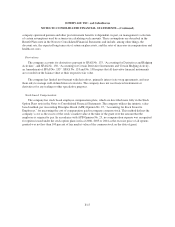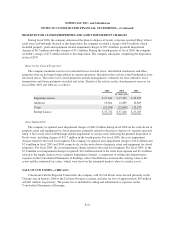Albertsons 2006 Annual Report Download - page 60
Download and view the complete annual report
Please find page 60 of the 2006 Albertsons annual report below. You can navigate through the pages in the report by either clicking on the pages listed below, or by using the keyword search tool below to find specific information within the annual report.SUPERVALU INC. and Subsidiaries
NOTES TO CONSOLIDATED FINANCIAL STATEMENTS—(Continued)
LIFO and Retail Inventory Method:
Inventories are stated at the lower of cost or market. Market is replacement value. Substantially all of the
company’s inventory is finished goods.
For a significant portion of the company’s inventory, cost is determined through use of the last-in, first-out
(LIFO) method. The company utilized LIFO to value approximately 65 percent and 64 percent of the company’s
consolidated inventories for fiscal 2006 and 2005, respectively. The first-in, first-out method (FIFO) is used to
determine cost for some of the remaining highly consumable inventories. If the FIFO method had been used to
determine cost of inventories for which the LIFO method is used, the company’s inventories would have been
higher by approximately $160.0 million at February 25, 2006 and $148.6 million at February 26, 2005.
The retail inventory method (“RIM”) is used to value retail inventory. The valuation of inventories is at cost
and the resulting gross margins are calculated by applying a calculated cost-to-retail ratio to the retail value of
inventories. RIM is an averaging method that has been widely used in the retail industry due to its practicality.
The company evaluates inventory shortages throughout the year based on actual physical counts in its
facilities. Allowances for inventory shortages are recorded based on the results of these counts to provide for
estimated shortages as of the financial statement date.
Reserves for Closed Properties and Asset Impairment Charges:
The company maintains reserves for estimated losses on retail stores, distribution warehouses and other
properties that are no longer being utilized in current operations. The company provides for closed property
operating lease liabilities using a discount rate to calculate the present value of the remaining noncancellable
lease payments after the closing date, net of estimated subtenant income. The closed property lease liabilities
usually are paid over the remaining lease terms, which generally range from one to sixteen years. The company
estimates subtenant income and future cash flows based on the company’s experience and knowledge of the
market in which the closed property is located, the company’s previous efforts to dispose of similar assets and
existing economic conditions.
Owned properties and capital lease properties that are closed are reduced to their estimated fair value.
Reduction in the carrying values of property, equipment and leasehold improvements are recognized when
expected net future cash flows are less than the assets’ carrying value. The company estimates net future cash
flows based on its experience and knowledge of the market in which the closed property is located and, when
necessary, utilizes local real estate brokers.
Adjustments to closed property reserves primarily relate to changes in subtenant income or actual exit costs
differing from original estimates. Adjustments are made for changes in estimates in the period in which the
changes become known.
The expectations on timing of disposition or sublease and the estimated sales price or sublease income
associated with closed properties are impacted by variable factors such as inflation, the general health of the
economy, resultant demand for commercial property, the ability to secure subleases, the creditworthiness of
sublessees and the company’s success at negotiating early termination agreements with lessors. While
management believes the current estimates on closed properties are adequate, it is possible that market conditions
in the real estate market could cause changes in the company’s assumptions and may require additional reserves
and asset impairment charges to be recorded.
F-15
























